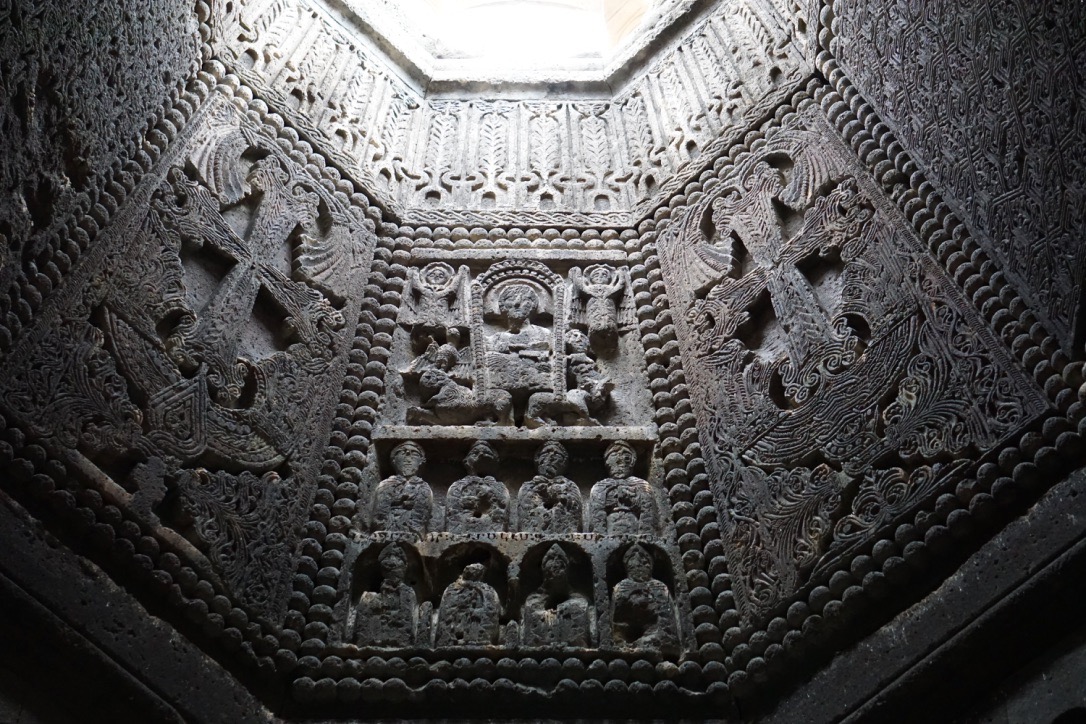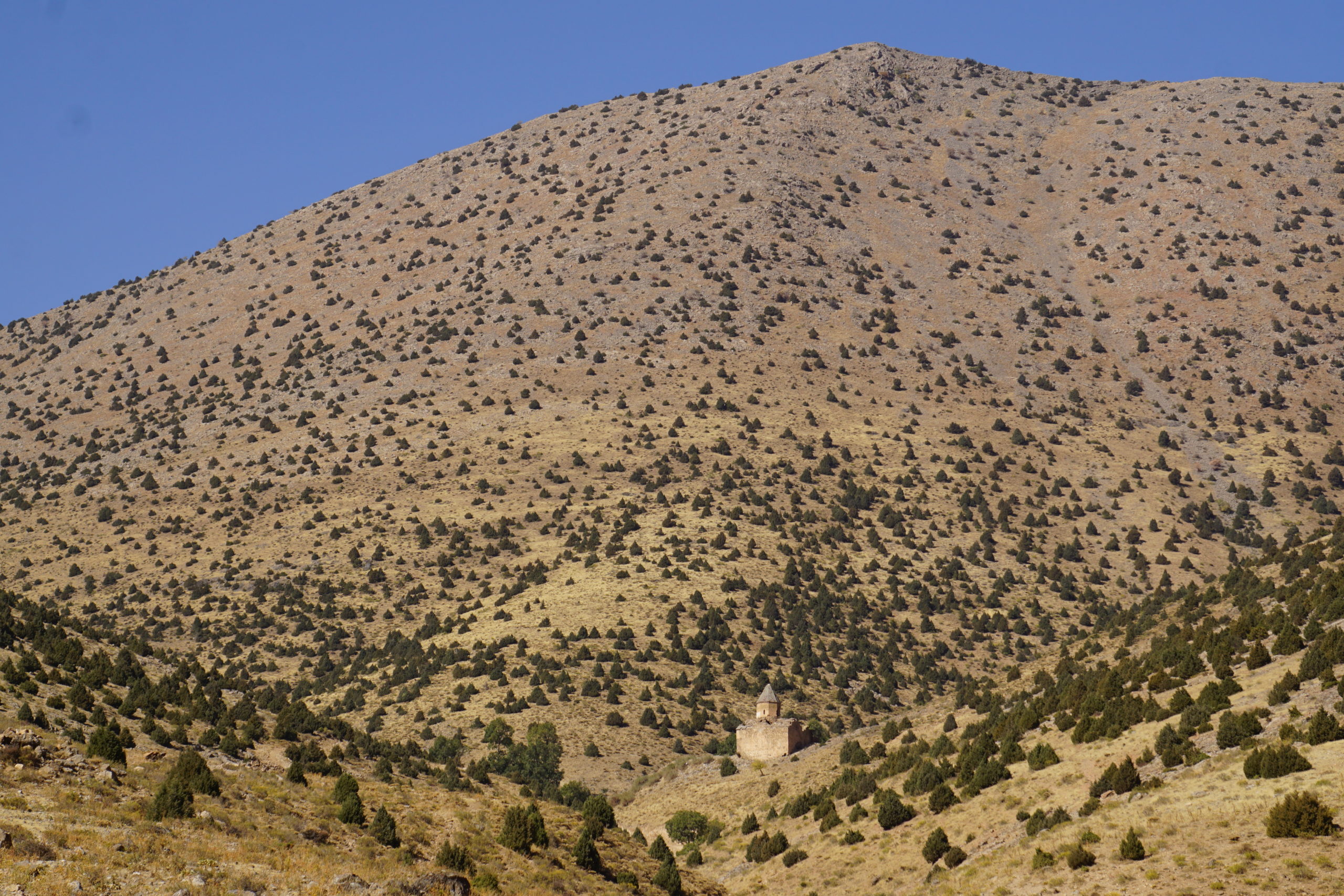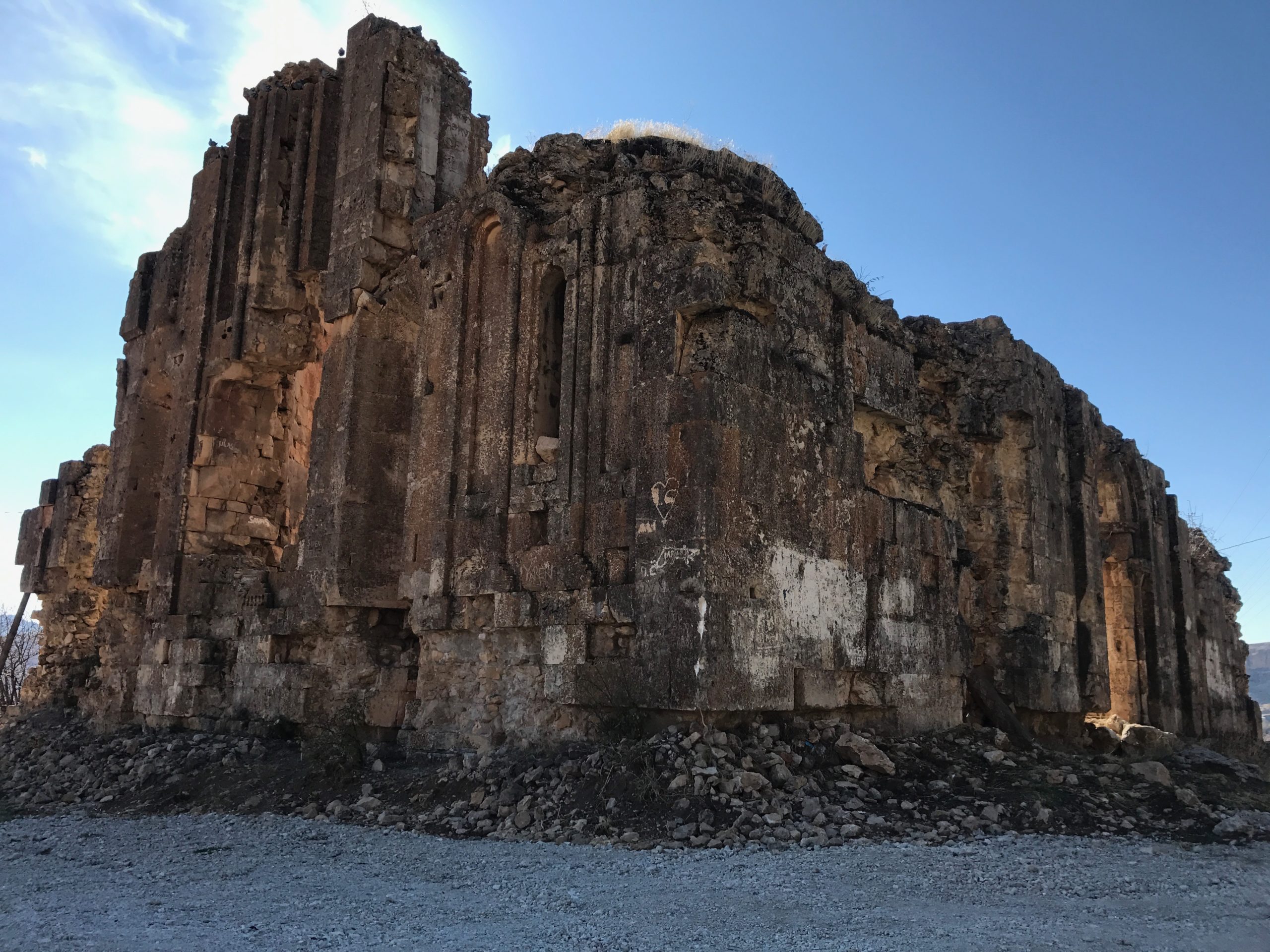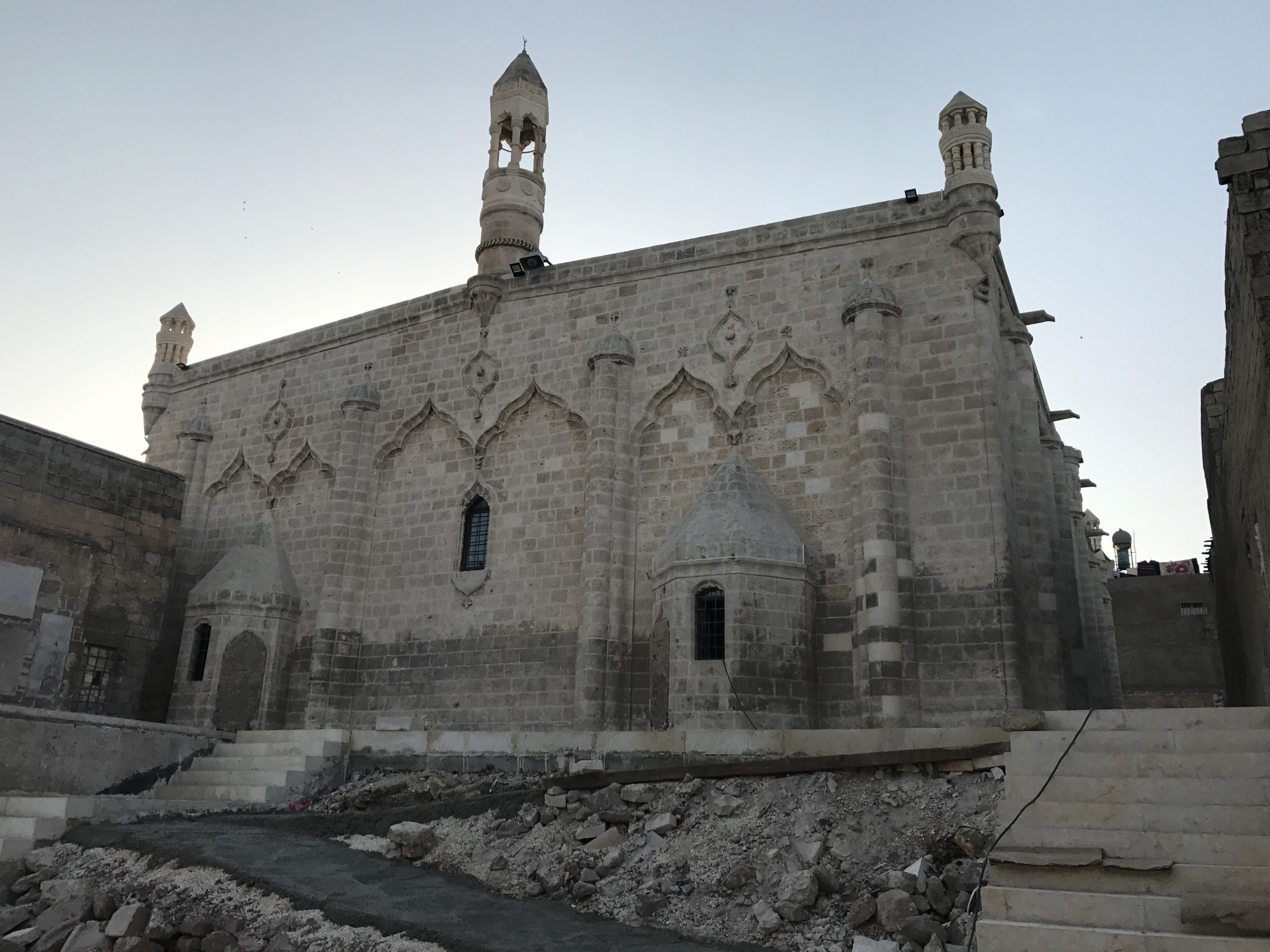Taking advantage of an unexpected interval between jobs, I decided to fulfill a dream and explore a rather remote part of the world where one of the most ancient still-surviving cultures was born and continues to exist.
After exploring Georgia, Armenia and Karabakh, I crossed the Georgian-Turkish border to Hopa and then rented a car to Artvin. In the mountains of Artvin I was searching for hidden and abandoned Armenian-Georgian monuments. In the lush, mountainous area I was able to locate the churches of Parkhali and Ishan, two ninth century basilicas. The basilicas were part of medieval Georgian monastic complexes. However, I was informed by locals that the architect was most likely Armenian and that they also served the needs of the local Armenian community. In fact, the churches probably served the cultural, spiritual and liturgical needs of both communities. There is a close link between the countries since the Bagrationi dynasty of Georgia was related to the Bagratid dynasty of Armenia (ninth century).
Further south, driving through tunnels cutting through the mountains, I visited two other monastic complexes in the Tortum gorges, the Khakhuli Monastery now used as a mosque and Osvang Monastery on the way to Erzerum. Again I observed the fusion of the Georgian and Armenian cultures to satisfy the needs of both communities, similar to the fusion of the Greek and Armenian cultures in the area of Caesarea, Cappadocia, where places of worship served as common ground for preservation of faith and identity, especially under conditions of threat and adversity.
I finally reached Erzerum where Seljuk culture was established after the battle of Manzikert in 1071 and the final entry and establishment of the Turkish tribes in Asia Minor. The atmosphere in Erzerum was very religious and conservative. I was able to locate Sanassarian Armenian College, confiscated by Kemal Ataturk, where he proclaimed the resolutions of the Erzerum Congress in 1919, long threatened by the desires of the subjugated Armenian and Greek nations for liberation and autonomy and the Great Powers using these desires to fulfill their imperialistic ambitions.
The host at Sanassarian College received me with enthusiasm and emotionally explained to me the significance of the Congress for Turkey. I told her I was Greek. She told me we were brothers and greeted me warmly. I then asked her where the Armenian church of Erzerum was. At first she looked at me with some suspicion, but then she showed me the way. She asked why I was looking for it, and I told her that I admire Armenian architecture and culture and wanted to photograph it. She subsequently gave me directions to a beautiful Armenian home in the center of Erzerum, now serving as a museum of Mustafa Kemal Ataturk. She told me the building originally belonged to an Armenian family and was very beautiful. It was clear to me that the most beautiful Armenian buildings had been confiscated to serve the needs of the newly-formed Turkish government due to their aesthetic value and functional capacity.
I went from Erzerum to Erzincan after visiting Surp David Abrank with its magnificent khachkars still standing on the top of the mountain. These were magnificent stone sculptures with carved symbols that served as a medium between humankind and the divine. The use of stone to express such emotional and spiritual needs is reminiscent of the most ancient civilizations.
Further west to Erzincan and in the Kemah gorge, the natural topography is magnificent. The Euphrates river flows in a serpentine way among the mountains of various geological shapes and colors, probably a result of eroded compact lava formations.
I had entered upper Mesopotamia, which had given birth to the most ancient and important civilizations. It occurred to me that the Armenians are probably the descendants of the ancient Mesopotamian people, still surviving, who had learned after years of experience to carve the stone and precious metals.
I remembered the documentary “The River Ran Red” and was imagining how this beautiful place would have looked in those dark and notorious days of 1915 when one of the multiple crimes against the Armenian inhabitants was committed or how it would have felt to live at that time.
From Erzincan I drove to Kars, one of the ancient Armenian capitals, after Artashat, Tigranakert, Vagharshapat and Dvin. I visited the magnificent Kars castle and the hill beneath it where the prosperous Armenian population was once settled. The beautiful Armenian cathedral with the stone-carved twelve apostles had narrowly escaped destruction. I climbed up the hill to an abandoned Armenian church. The settlement on the hill had been destroyed. In the city’s museum I saw a picture of old Kars which reminded me of Harpert. It is typical to find Armenian settlements on the mountain slope under ancient Urartian castles – Kars, Harpert, Van, Palu, Yerevan, among others. It serves as proof of origin and historical continuity. I also found ancient Urartian pottery and the magnificent carvings of a wooden door from an Armenian church before its demolition. While there I met some Turkish visitors from Istanbul who informed me the door was Russian to which I responded that it was Armenian, not Russian.
Kars and Van testify to the activity of Russian expansionism which took advantage of the Armenian’s aspirations for liberation. The Armenians, abandoned by the Russians after the Bolshevik Revolution in 1917, were left to the wrath of the retaliating Turks. Kars had a strong sense of the Armenian-Russian tradition with its classical architecture reminding me of Gyumri and the tuff (porous rock formed by consolidation of volcanic ash) architecture of Yerevan. The cities of Kars and Gyumri encircle Ani and bear its architectural and cultural tradition.

After Kars, I spent two days in Ani and was able to visit Horomos monastery with its splendid zhamatun arch with stone carvings of God, the four Evangelists, King Gagik and his descendants. Ani was one of the ancient Armenian capitals and a creation of architect Trdat who had helped with the restoration of the dome of St.Sophia in Constantinople-Istanbul. The beauty of the city is unparalleled. Climbing to its citadel, I also found an ancient Persian fire temple and a mosque, proof of the existence of other cultures within the Armenian city. The Akhurian river separates Ani from its Armenian motherland with a broken ancient bridge standing as a political symbol and birds flying undisturbed from one border to the other.
From Ani I drove to Khtzkonk. I visited the five-church complex where only one of them is still standing. It was obvious that the other four had been blown up. The remaining single-room rotunda reminded me of the first and earliest churches in Yerevan, the transition from the ancient world to Christianity and Armenia’s status as the first country to officially convert to Christianity in the fourth century.

Further south I drove to Lake Van, cradle and capital of the Urartu-Armenian culture in the ninth century BC. I visited the fortress, the burned city, the four islands and the monasteries surrounding them. Van is a magical place. The color of the lake and the sky change multiple times during the day, the water is rich in minerals and the fish tastes metallic. I walked up the age-old Urartian fortress and thought about the ancient Armenian cities built under the old fortresses/acropolis. I reflected on the heroic battle and final burning of Van and the crisis of Armenian refugees, reminiscent of the burning of Smyrna and the crisis of Greek refugees.
I walked with awe among the remains of the burned city and conversed with a Turkish archaeologist, who passionately expressed to me his adoration of Armenian history and his efforts to excavate the past and reveal the continuity of history. We both agreed that the loss was immense and that the need was imminent to acknowledge and to coexist.
From Van I drove to Bitlis and walked up the castle of Alexander and the Armenian neighborhood made of tuff. Bitlis hosts one of the best-preserved Armenian settlements. The tuff provides ideal temperature, is easily carved and has been used by Amenians to build the most beautiful structures.

Next I visited Mush and the destroyed monasteries of Surp Arakelots and Surp Garabed. It was obvious that there was an explosion, and the stones of the monastic complexes have been used by the local Kurds to build their modern houses. I searched the structures of the modern Kurdish houses, and among them I found stones with Armenian inscriptions and Christian symbols that had been taken from the destroyed Armenian monastic complexes.
Visiting Harpert under the shadow of its castle and the relics of the destroyed city and an Armenian church, I could not locate any ruins of the famous Euphrates College of Harpert, founded in 1852. I was impressed by the existence of Armenian-American Universities as early as 1852 in the area, proof of the high level of education, intellect and culture of the prosperous Armenian population. From there I crossed by boat to Dersim – Chmshgadzak, Mazgerd, Mirnav and Yergan. I remembered the tragic story of Aurora Mardiganian from Chmshgadzk.

I crossed the Euphrates to Malatya and visited a few Armenian churches and the Armenian cemetery. Malatya is the hometown of Hrant Dink and his heroic efforts to restore the truth, to make it public, to acknowledge, to reconcile and his subsequent martyrdom.
Urfa was the next stop where I visited the church of Surp Arakelots, now Firfiri mosque, in the Armenian neighborhood where a resistance took place in 1915. The Armenian neighborhood of Urfa lies on the hill over the ancient Armenian cemetery which again serves as proof of historical continuity. I visited the splendid Armenian monastery in Germush and from there drove to Mardin where a small Armenian and Assyrian Christian community still exists. I visited an endangered Armenian church and the Assyrian monastery of Mor Hananio overlooking an ancient Babylonian temple to the Sun god, as well as several Assyrian monuments surrounding the Midyat area. Ancient temples had been used and remodeled by the Assyrians to serve their cultural, spiritual and religious needs.

After Mardin I visited Diyarbakir, walked around the city on the black walls and visited Surp Sarkis with its superb gothic architecture. I wondered if, after all, gothic architecture had its origins in Armenia. I had the same impression when I visited the churches of Gandzasar and Dadivank in Artsakh-Karabakh. The gothic architecture of Surp Asdvadzadzin with its splendid arches in nearby Chunkush is an additional clue to the origins of gothic architecture. It seemed to me that Artsakh-Karabakh was the border and shield of the west and that Armenian culture and tradition was the easternmost frontier and guard of western culture.
I then drove to Chunkush and Adish and visited the Duden gorge, another site of mass murder in 1915. There were a series of massacres against the Armenian population from the late 1800s (including the Hamidian massacres of 1894-1896) to 1915, reaching the threat of physical extinction when the Turkish troops approached Yerevan. The Armenians reluctantly surrendered to the Soviet Union as a means to survive, which proceeded to partition Armenia once again between Turkey. The Museum of Modern Art in Yerevan continued to deviate from Soviet dogma and is still a monument of resilience and survival.
Leaving Diyarbakir, I drove back to Harpert and from there to Arapgir. I visited the Armenian neighborhood and cemetery of Arapgir. I found gorgeous multi-story Armenian mansions in Arapgir where I imagined the first floor was used for the storage of produce and those above probably housed the families with many generations living together. I became aware of Armenian architecture, its style, aesthetic value and functional purpose, as well as the difference in socioeconomic status between Armenian and neighboring populations.
I visited Sebastia and Caesarea. Both cities were radically Islamized, as proven by the multiple Islamic monuments within the walls. It is notable how the city within the walls was conquered by the Turks, leading to the expulsion of the Christian population to settlements outside the walls and to a precarious coexistence between the two religious groups. The same phenomenon of establishment of Christian populations outside the city walls is noted in Constantinople-Istanbul, in Ammochostos-Famagusta in Cyprus, and in Rhodes.
When I reached Aintab the Armenian mansions and churches appeared as evidence of the prosperity of the Armenian merchants on the trade routes between east and west.
Historically west met east and communicated via the Silk Road and the royal Persian road from Sousa to Sardis. Barter transitioned to trade and commerce was born enabling people to communicate, exchange produce, invent and learn from one another.
From Aintab I visited Marash and the historic village of Zeitun. Similar to the situation of Trebizond in the Black Sea where the Greeks had to move to the mountains to survive and to gain some autonomy forming the seven settlements of Santa, the Armenians moved to the mountains of Zeitun for survival and autonomy. I photographed one of the last Armenian houses of Zeitun as I walked with a local among newly carved roads in Zeitun and was warned that the roads cut through old Armenian cemeteries. My companion reached his hand into the soil on the side of the roads and pulled out bones.
Continuing on to the mountain of Musaler, I remembered the heroic resistance of the Armenian population of the six villages – Kaboussieh, Yoghunoluk, Bitias, Vakef, Kheter Bey and Haji Habibi. I studied the cemetery of Vakef and conversed with the Armenians of Vakef who had returned to their ancestral land in 1918.
Finally I headed to Cilicia via Iskenderun. I visited the Armenian church of Karasun Manuk in Iskenderun built in 1872 followed by Dortyol, Belem, Adana, Tarsus and the castles of Cilicia.
The Greek-Byzantines (Rum) resettled the Armenian population in Cilicia in the eleventh century to protect their territory from the Arab invasions which had started in the seventh century.
Lake Van and upper Mesopotamia are the cradle, epicenter and natural habitat of the Urartu-Armenian civilization, expanding in centripetal circles to Yerevan and Artsakh-Karabakh.
Cilician Armenia is a place of resettlement for strategic and political reasons. The political situation in Cilicia got more complicated after the arrival of the Crusaders in the area and the attempt to Latinize the Armenian church under the dynasty of Lusignan, which links the Armenians, the Crusaders and Cyprus.
I visited the castles of Sis, Anavarza, Fekes and Hajun. Climbing the castles of Cilicia, I tried to understand what was Assyrian, what was Hittite, what was Roman-Greek and what was Armenian. I witnessed layers of history, each civilization building on the other and each leaving its traces.
In a quest for authenticity, truth and the origins of the world, I kept driving and walking for hours among the historical places surrounding Lake Van and upper Mesopotamia in search of monuments and traces from the past, trying to understand what happened to the Armenians and the events that led to the current situation. Mesopotamia is a field where many cultures met, clashed and fused – Sumerians, Assyrians, Babylonians, Hittites, Urartu, Armenians, Greeks, Persians, Romans, Arabs, Turks, Mongols and others.
Among the inhabitants of the area, the Urartu-Armenians are probably the most ancient, potentially descending from the Mesopotamians. Indigenous of a very precarious geographical location, they have been subject to partition and mass movement of population multiple times, in 387 and 591 between the Greek-Byzantine (Rum) and the Persians and in 1555 and 1639 between the Ottoman Turks and the Persians. The third partition in 1555 led to the mass population movement and forced migration to Persia and the formation of the Persian-Armenian community.
It is also inevitable not to draw some historical parallels between the Armenian and Greek nations such as the destruction of Greek Smyrna and the destruction of Armenian Van and the population exchange in 1988 between Armenia and Azerbaijan, in 1922 between Greece and Turkey and in 1974 between Greek and Turkish Cypriots.
In addition to the historical and political context, it is important to recognize the role of Armenian civilization in the birth of the Renaissance, the transition from the ancient to the Christian world and the safeguarding of the border of western culture to the east. The Armenians have left monuments of outstanding and unparalleled aesthetic and technical standards in architecture, sculpture and music.
The multiple pogroms against the Armenian population collectively leading to the Armenian Genocide before, during and after 1915 are followed by genocide of memory and culture in an effort to eradicate the traces of an ancient civilization. The continuing genocide is being committed through the denial of the historical events, the fanaticism penetrating the Turkish educational system and modern political ideology and the destruction of remaining Armenian monuments.
The survivors of the Genocide formed the Armenian diaspora and were here to tell the story of what happened. They helped us study our origins and preserve memory, commemorating history and its creators while moving forward to the future. A nation cut from its roots is alienated from its historical conscience and is in danger of losing its historical continuity and orientation.
As I reflect, I remember the ancient prophecy from the stone sculpture of the dome of the zhamatun of Horomos Monastery in Ani and a painting in Cappadocia of a similar theme:
the four Evangelists—Matthew in the human form, Mark in the form of a lion, John in the form of an eagle and Luke in the form of a bull, all spreading the truth. It is the word of the creators of history and art and the word of those who excelled and were betrayed and victimized. It is the word of memory and historical conscience, all of which led to my trip to fulfill a dream.



Bravo!
What a great adventure! I wish more of us could make this pilgrimage to our homeland. Learn more in my latest book, The Armenian Highland.
Dear Mr Karanian,
Thank you for your message.
I have read your book ‘Historic Armenia after 100 years’.
I am interested in connecting with you to exchange photographs and ideas.
With kind regards,
Anastasios
Efkharisto, Dr. Mavrakis on a wonderfully written account of your travels through my ancestors’ homeland. Turkey’s eradication of Armenian history is very intentional and painful to observe. Only by studying and remembering the past can we push back against the rewriting of history.
What an experience, wish I had been there. Dolores
Thank you for documwnting your trip and publishing it in AW.
I tried to find an Armenian church in Erzerum in 1992 but was told it was no longer there. I would be very interested to know if you actually found it and if so, if you could share some details and a photo.
If Xaristo
Dear Mr Antoine Stépan Terjanian,
Thank you for your message.
I have found and photographed an Armenian church in Erzerum. It is now functioning as a mosque.
If you are interested, I can send you some photographs.
With kind regards,
Anastasios
anmavrakis@msn.com
Dear Mr Terjanian,
I did find a church in Erzurum.
If you are interested, I can email you some photographs.
With kind regards,
Anastasios
Hi, Summer 2015, I visited both Armenia’s, in Erzurum, I saw one Armenian Church closed, in one of the armenians old quarters, and the the in the fortress of Erzurum…
Best regards. Adrine K.
Beautiful article, my dear Anastasios. So proud of your magnificent trip!
Thank you very much Dr Mavrakis.
Modern day so-called “civilised” western powers are much to blame for turning a blind eye on the ongoing genocide of the ancient Armenian, Greek and other monuments. It is extremely frustrating for me and countless children of Genocide survivors ( now in our 70’s and 80’s) to witness the continued savagery desperately unable to put a stop to it. At this moment in my life I’m painfully convinced that not much – if anything- will change in the foreseeable future. It is extremely comforting however to have brilliant minds like your good self , prof. Taner Akcam and others brave enough to expose the truth. Efkharisto para poli!
Wonderful article. Thank you
Very very interesting and enlightening. Thank you so very much for this gift to us Armenians and the free world. Your travels and accounts of the experiences made me feel like I was travelling along. You are an honorary Armenian by all means.
Much respect to your commitment and honest reporting.
Dear Mr Hamalian,
Thank you very much for your kind words.
The Armenian culture is one of the most ancient cultures still existing.
I want to thank you for all the beauty I was able to see and photograph during my trip. The Armenian aesthetics are unparalelled. I hope this precious cultural heritage will be preserved for all of us to admire. I did my best with my photographic machine.
Thank you again.
With kind regards,
Anastasios
Dear Mr Hamalian,
Thank you very much for your kind words.
The Armenian civilization is one of the most ancient civilizations still existing.
I want to thank you for all the beauty I was able to see and photograph during my trip. The Armenian aesthetics are unparalleled. I hope this precious cultural heritage will be preserved for all of us to admire. I did my best with my photographic machine.
Thank you again.
With kind regards,
Anastasios
Thank you! I have been to Georgia, Armenia and the east of Turkey. I am a witness.
Bravo Tasso εξαιρετικό !
Anastasios,
Beautiful photos and a most interesting and informative
publication.
Blessings,
Stephanie (Metropolis) Peterson